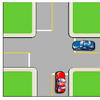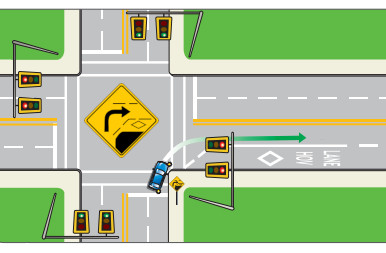 Intersections are dangerous places. Yielding right of way is probably the main concern, but the path you travel through one is just as important. Some drivers are so sloppy with their turning technique that they activate the traffic signals by driving over the detection loops in the oncoming lane when they exit the intersection!
Intersections are dangerous places. Yielding right of way is probably the main concern, but the path you travel through one is just as important. Some drivers are so sloppy with their turning technique that they activate the traffic signals by driving over the detection loops in the oncoming lane when they exit the intersection!
Signs & Pavement Markings
As you approach an intersection, your ability to turn there may be controlled by signs and pavement markings.

Scan for these signs and markings, being prepared before you arrive at the intersection. They are not suggestions, you must follow their directions. It is possible that the turn you hope to make will not be permitted.
Turning Right
If you are turning right at an intersection, you must approach and exit as close as practicable to the right hand curb or edge of the roadway. If there is no curb, remember that the roadway ends at the solid white line on the right, or if there is no solid white line, then the edge of the pavement.
Turn into the first available lane on the right.
Many drivers tend to use the shoulder to the right of the solid white line as another lane. This is both unsafe and illegal.
HOV Lanes
Learn to Drive Smart, our provincial driver's manual, explains this special circumstance involving restricted lanes:
The driver of the blue car has seen the warning sign indicating that there is a reserved lane on the street the driver wishes to turn onto. The driver should turn into the lane next to the reserved lane, unless they are entitled to drive in the reserved lane and wish to drive in it.
To turn right off of a street with a reserved lane, change lanes into the reserved lane where permitted and when safe.

Turning Left
If you are turning left at an intersection, you must approach in the lane nearest to the center line, remaining to the right of the center line as you enter. Exit the intersection into the lane closest to the center line keeping to the right of the line.
Turn into the first available lane for your direction of travel.
If possible, make the turn to the left of the center of the intersection. This will allow traffic from both directions to make left turns without meeting each other in the middle.
Wide Turns
The term "as close as practicable" is mentioned in the legislation governing turns. Cars and pickup trucks can usually follow the turn radius that the intersection size allows. Swinging wide in the manner of a longer vehicle to anticipate a turn is not an option for these drivers.
Multiple Turn Lanes

Some intersections allow multiple lanes to turn right or left. If this is allowed, follow the lines and signs for the lane that you are in. Enter and exit the intersection using the same lane.
Share This Article
Rights and duties of operator of cycle
183 (4) Despite section 165, a person operating a cycle who intends to turn it to the left at an intersection where there is more than one lane from which left turns are permitted must
(a) cause the cycle to approach the intersection in the lane closest to the right side of the highway from which a left turn is permitted,
(b) keep the cycle to the right of the line that divides the lane referred to in paragraph (a) from the lane immediately to the left of that lane,
(c) after entering the intersection, turn the cycle to the left so that it will leave the intersection to the right of the line referred to in paragraph (b), and
(d) when practicable, turn the cycle in the portion of the intersection to the left of the centre of the intersection.
- Log in to post comments
- Log in to post comments

Multiple left turn lanes rules for cyclists: